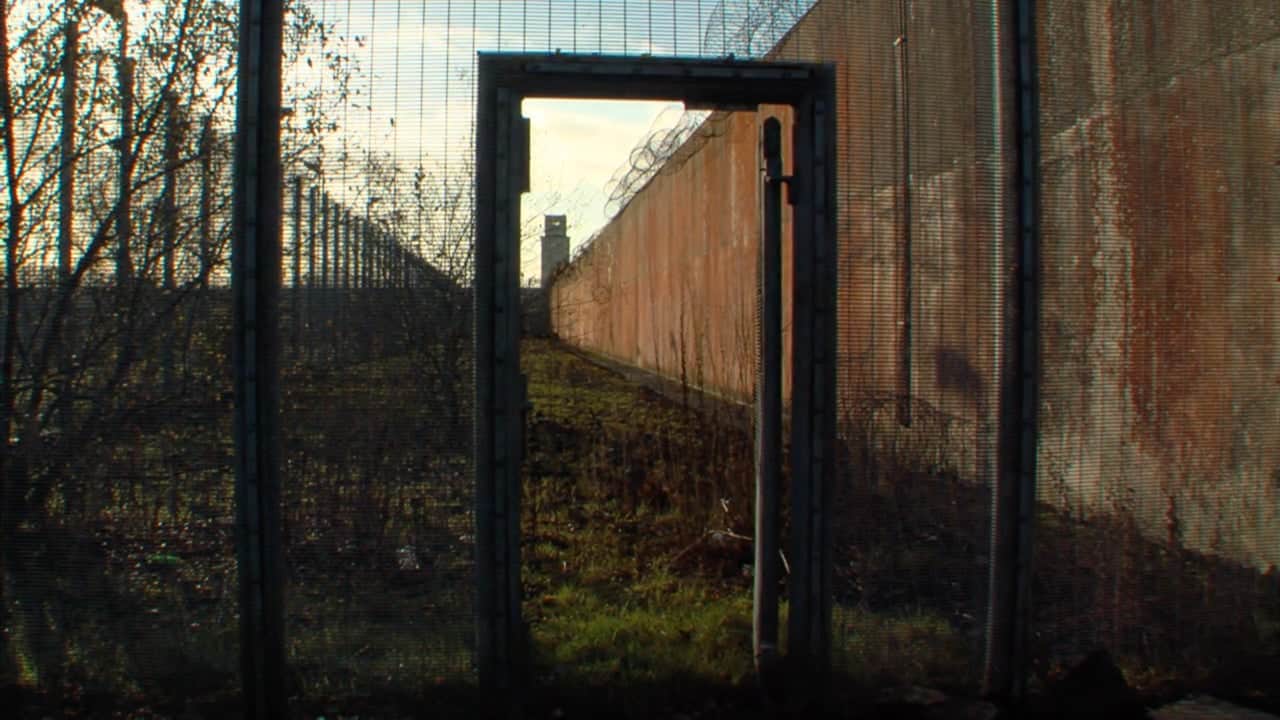The H-Blocks
The H-Blocks were constructed adjacent to the compounds/cages of Long Kesh, on the site of a disused military airfield near Lisburn, south of Belfast, and opened in 1976. The building of the H-Blocks aligned with the policy of criminalisation and the removal of Special Category Status on 1 March 1976. Any prisoners sentenced after this date were imprisoned in the H-Blocks as opposed to the cages/ compounds of Long Kesh.
The eight H-Blocks – so named because of their uniform ‘H’ shaped plan – collectively formed a purpose-built maximum security prison for political prisoners. Unlike the compounds/ cages of Long Kesh which housed prisoners collectively in Nissen huts, the H-Blocks separated prisoners into individual cells. Each H-Block was surrounded by a concrete wall topped with barbed wire, and gates within the complex were constructed of solid steel. The entire site was also encircled by watch towers and a perimeter wall. The large complex also included a separate hospital building, a visiting building, multidenominational chapel and two large football pitches, alongside multiple administrative buildings.
The H-Blocks were witness to many significant events of the conflict including the blanket protest, the no wash protest and the 1981 hunger strikes. And on 25 September 1983, thirty-eight PIRA prisoners escaped from H-Block 7 by taking prisoner officers hostage and hijacking a food lorry. Subsequently, loyalists and republicans were housed in different wings and later into different blocks.
The history of the H-Blocks was marked by a change of conditions over the years. There was a loosening of restrictions in the later years of the conflict. In fact, from 1994, prisoners were allowed free association within both their wing and the adjacent wing, and telephones were introduced in 1995. The H-Blocks were emptied and the prison was closed in 2000 as a result of the Good Friday Agreement, and demolition began in 2006. Today, just one H-Block remains standing.
Learn More Here
Source
Article
Flynn, M. (2011)
Decision-making and Contested Heritage in Northern Ireland: The Former Maze Prison/Long Kesh. Irish Political Studies, 26(3)
Green, M. (1998)
The Prison Experience – A Loyalist Perspective. Published by EPIC.
Campbell, J.B., McKeown, L. and O'Hagan, F. (1994)
Nor Meekly Serve My Time: The H-Block Struggle, 1976-1981. Published by Beyond the Pale.
Parallel Stories
Watch the clips of former prisoners in the H-Blocks. How do their perceptions of life in the H-Blocks differ? Why?
This is an architecture that grew out of the whole horrific conflict situation
Oliver
Watch the clip of Oliver. Do you agree that the architecture of the H-Blocks conveys something of the nature of the conflict in Northern Ireland? Why?
We Were There (2014)

This feature film, directed by Laura Aguiar and Cahal McLaughlin, highlights the experiences of women in the predominantly male world of the Maze and Long Kesh Prison.
Running time: 61 min
Links to NI Curriculum
CCEA GCSE History: Unit 1; Section B; Option 2: Changing Relations: Northern Ireland and its Neighbours, 1965–1998
Questions based on GCSE CEA history exam papers
01.
Using the clip of Seanna and your contextual knowledge, do you agree that the hunger strikes of 1981 did lead to changes in life in the H-Blocks for the prisoners? Give two reasons.
02.
Using the clip of Oliver and your contextual knowledge, do you agree that the architecture of the H-Blocks was symbolic of the nature of the conflict in and about Northern Ireland? Give two reasons.
03.
How useful is the clip of David for an historian studying prisoner experiences of the H-Blocks in the later years of the conflict? Explain your answer, using the clip and your contextual knowledge.
Download our teacher's notes
- Coming Soon




